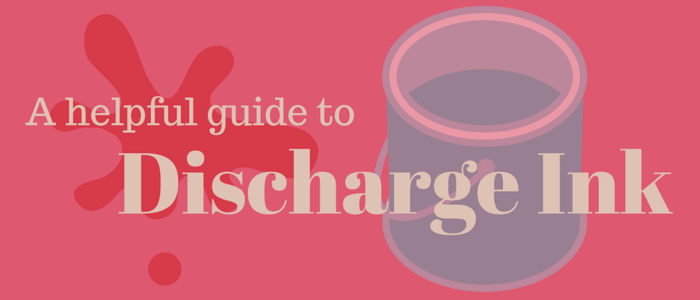No products in the cart.
en

Revolutionizing the screen printing industry through cutting-edge technology and quality service
Phone: +1 847-367-9760
Anatol Equipment Manufacturing Co.
1429 S Shields Dr
Waukegan, IL 60085

Revolutionizing the screen printing industry through cutting-edge technology and quality service
Anatol Equipment Manufacturing Co.
1429 S Shields Dr
Waukegan, IL 60085

As a printer, you may find yourself asking “Why am I struggling to get these results with dark fabric?”
Water based inks work great with light colored garments, but the transparent properties make getting a good result on dark shirts tough. Plastisol can give you vibrant prints on dark material, but you sacrifice the softness for a heavier hand.
Discharge ink is water based ink mixed with an additive that essentially bleaches (or discharges) the manufacturer’s dye out of a dark colored garment, returning it to its natural color (usually an off-white). This allows you to add pigment of your choice to create a good looking distressed color print with a soft feel that wouldn’t be possible using plastisol. The most common discharge inks are clear or white in appearance with formaldehyde additives, the active ingredients which remove the dye from the fabric.
The ink manufacturer will include the formula for mixing up a batch – ratios of the base, pigment (if desired) and powdered bleaching agent by weight. It’s important to have a good quality scale with a high enough resolution for weighing small amounts of additives. Sometimes the stated formula might not be exactly what you’re looking for, so you should experiment with different ratios until you get the desired result.
Discharge inks have been around for quite some time but their popularity comes and goes as they present both great opportunities and some challenges. They can be somewhat unpredictable, meaning that not all printers achieve the look they want. While there are numerous reasons this may happen, a good understanding of the properties of discharge ink will help avoid some of these mishaps.
Before you grab some discharge ink and run with it, it’s important to know that the discharge method is most effective when using 100% cotton fabric. Discharge ink seeps into the fabric and strips the garment of its color wherever applied, but it’s only effective on cotton. This means that if you’re printing on garments spun from blended threads, it’s only going to dye the cotton threads. The resulting weathered, vintage look might be what you’re after, but if not, stick with 100% cotton. Also, discharge ink will only remove reactive dyes from garments, and it can be near impossible to get a good discharge result on certain dyes and colors. If you’re not sure whether your garment will properly discharge, your shirt manufacturer should be able to tell you. Because of the unpredictability of discharge ink, it’s a good idea to do a test run before you begin full-scale production.
Like any water based ink, discharge inks don’t have a very long shelf life. They can be more expensive than traditional screen printing ink, so be careful not to make more than you need for the job. Also, because they’re water based, discharge inks can dry in the screen quickly, so be careful not to leave them sitting too long while printing!
Once your print is on the garment, you may notice it doesn’t look very impressive. This is because discharge ink is heat activated and must cure in the dryer before reaching the desired effect. Because discharge inks are water based, they require a dryer that is powerful enough to evaporate all of the water solvent in the ink in order to properly cure it. Without the dryer providing forced air to the garment, the curing process will need to be repeated, slowing down production. It’s also important to note that mistakes cannot be spot cleaned because the fabric of the garment has been bleached. So print with caution!
When mixing discharge ink, it’s important to use a well ventilated area. Wearing gloves will prevent the formaldehyde byproduct from irritating your skin during the mixing process. The curing process for discharge ink involves the evaporation of water within the mixture; the steam byproduct brings out sulfuric vapors from the formaldehyde. It’s very important that your dryer has proper ventilation and you take the necessary precautions when dealing with the noxious gas produced during the curing process. One of the biggest turn-offs for screen printers using discharge ink is its bad smell, though new improvements can limit this annoyance.

A well-ventilated Anatol Vulcan dryer will give you the air circulation you need for effectively curing water based prints, like those using discharge inks.
Just like water based ink, discharge ink must be carefully disposed of in the same fashion you would get rid of other inks with hazardous properties. Garments printed with formaldehyde based discharge should be washed after curing, as there is still formaldehyde present in the print that can cause irritation. Also, washing will help bring out the softness of the print. Be careful – some discharge inks may be advertised as formaldehyde-free but still contain potentially hazardous additives.
While discharge printing might sound scary, it really isn’t much more dangerous than any other type of screen printing. Follow the instructions for mixing, printing, curing and disposing your ink and use the same good judgment and common sense you would for any print job.
Screen printing with discharge ink is the best way to apply a soft, vibrant, water based print to a dark garment. It gives you a natural feel that plastisol can’t match and an opacity traditional water based inks can’t reproduce on dark colors. It has some limitations to consider, but if printed and cured correctly, your end product will be everything your customers are looking for!
Need help mixing batches of ink? Dryer slowing you down? Contact Anatol today and we’ll get you the right equipment for any printing job.
Your message was successfully sent!